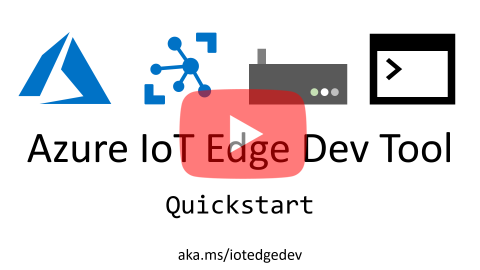The IoT Edge Dev Tool greatly simplifies Azure IoT Edge development down to simple commands driven by environment variables.
- It gets you started with IoT Edge development with the IoT Edge Dev Container and IoT Edge solution scaffolding that contains a default module and all the required configuration files.
- It speeds up your inner-loop dev (dev, debug, test) by reducing multi-step build & deploy processes into one-line CLI commands as well as drives your outer-loop CI/CD pipeline. You can use all the same commands in both stages of your development life-cycle.
For the absolute fastest way to get started with IoT Edge Dev, please see the Quickstart section below.
For a more detailed overview of IoT Edge Dev Tool including setup and commands, please see the Wiki.
This quickstart will run a container, create a solution, setup Azure resources, build and deploy modules to your device, setup and start the Edge simulator and then monitor messages flowing into IoT Hub.
Here's a 3 minute video walk-through of this Quickstart:
The only thing you need to install is Docker. All of the other dev dependencies are included in the container.
-
Install Docker
- Open Docker Settings and setup a Shared Drive that you'll use to store your IoT Edge Solution files.
- Windows
- Be sure to check whether you are running in Linux container mode or Windows container mode.
- Linux
- We've seen some issues with docker.io. If Edge doesn't run for you, then try installing Docker CE directly instead of via docker.io. Use the CE install steps, or use the convenience script.
- By default, you need
sudoto rundockercommands. If you want to avoid this, please follow the post-installation steps for Linux.
-
Run the IoT Edge Dev Container
Before you run the container, you will need to create a local folder to store your IoT Edge solution files.
Windows
mkdir c:\temp\iotedge docker run -ti -v /var/run/docker.sock:/var/run/docker.sock -v c:/temp/iotedge:/home/iotedge microsoft/iotedgedevLinux
sudo mkdir /home/iotedge docker run -ti -v /var/run/docker.sock:/var/run/docker.sock -v /home/iotedge:/home/iotedge microsoft/iotedgedev -
Initialize IoT Edge solution and setup Azure resources
iotedgedev initiotedgedev initwill run bothiotedgedev new .andiotedgedev iothub setup, which will create a new solution and setup your Azure resources in a single command.If you want to use your existing IoT Hub and IoT Edge device, you can run
iotedgedev new ., and update the.envfile with the IoT Hub connection string and IoT Edge device connection string.iotedgedev new .will add a default C#filtermoduleto the solution. To customize this behavior, useiotedgedev new . --module <module-name> --template <template> -
Add modules to IoT Edge solution
iotedgedev add <module-name> --template <template>Currently the available template values are
csharp,nodejs,python,csharpfunction. We are working on supporting more templates. -
Build IoT Edge module images
iotedgedev build -
Setup the IoT Edge Simulator
iotedgedev setup -
Start the IoT Edge Simulator to run the solution
iotedgedev startYou can also combine setup and start with
iotedgedev start --setup -
Monitor messages sent from IoT Edge Simulator to IoT Hub
iotedgedev monitor -
Stop the IoT Edge Simulator
iotedgedev stop -
Push IoT Edge module images
iotedgedev push -
Deploy modules to IoT Edge device
iotedgedev deployYou can also combine push and deploy with
iotedgedev push --deploy -
Monitor messages sent from IoT Edge Runtime to IoT Hub
iotedgedev monitor
Please refer to the Wiki for details on setup, usage, and troubleshooting.
Please refer to the Contributing file for details on contributing changes.
